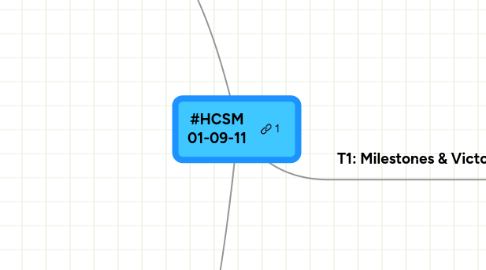
1. T2: Game Changers
1.1. Patient self-advocacy
1.1.1. Examples
1.1.1.1. Locate transplant donor
1.1.1.2. Crowdsource answers to health questions
1.1.2. Information
1.1.2.1. Information seeking
1.1.2.2. Information sharing
1.1.2.3. Beyond dissemation
1.1.2.3.1. Interpretation
1.1.2.3.2. Significance
1.1.2.3.3. Comparisons
1.1.2.3.4. Context
1.2. #hcsm
1.2.1. Community to support new HCSM users
1.2.2. Knowledge / expertise sharing
1.3. Enterprise social media
1.3.1. Use builds competencies within organizations
1.3.2. Yammer
1.3.3. Learning communities w/in organization
1.3.4. Professional societies engaging
1.3.5. Reduce or eliminate traditional marketing
1.4. Tech
1.4.1. Mobile health
1.4.1.1. Tablets & smartphones
1.4.1.2. 3/4G
1.4.1.3. Cheaper smartphones
1.4.1.4. Clinical apps
1.4.1.4.1. MobLibMed
1.4.1.4.2. Link set
1.4.2. Video calls
1.4.2.1. Skype
1.4.2.2. FaceTime
1.4.3. Integration of services
1.4.4. Convergence of tech
1.5. FDASM
1.5.1. Warning letters
1.5.2. Pharma increasing hesitancy to engage
1.6. Professional acknowledgement
1.6.1. AMA guidelines
1.6.2. ASCO
1.6.3. Mayo Clinic Center for Social Media (MCCSM)
1.6.4. Pfizer handbook
1.6.5. Tufts course
2. T3: What Hasn't Changed?
2.1. Challenges
2.1.1. Hospitals not wired
2.1.2. Hospitals block SocMed
2.1.3. Digital divide
2.1.4. HIPAA education
2.2. Net neutrality
2.3. People
2.3.1. HCSM "experts" who aren't credible to HCSM community
2.3.2. Lack of engagement in some communities
3. T1: Milestones & Victories
3.1. General
3.1.1. Early adopters community is broad spectrum (@GailZahtz)
3.1.1.1. Healthcare providers
3.1.1.2. Patients
3.1.1.3. Stakeholders
3.1.1.4. Caregivers
3.1.1.5. Patient Advocates
3.1.2. Shift of HCSM from marginal to central
3.1.3. Growing # of HCSM chat participants
3.1.4. Realization of peripheral impacts of HCSM
3.1.4.1. Mobile
3.1.4.2. Literacy
3.1.4.3. Global
3.1.4.4. Activism
3.1.4.5. Advocacy
3.1.5. Special purpose
3.1.5.1. Crisis & disaster communications
3.1.5.2. Clinical trial information accessible via SocMed
3.1.5.3. Hard-to-reach communities
3.1.5.3.1. Rural health
3.1.5.3.2. Homebound
3.1.5.3.3. Young adults
3.1.6. More awareness of privacy
3.1.6.1. in apps & platforms
3.1.6.2. in best practices
3.1.6.3. means HCSM less risky, more appropriate, more useful
3.1.7. Specifics
3.1.7.1. Shift from "from shiny toy to lets make meaning happen" (@mindofandre)
3.1.7.2. "communicating, crowdsourcing and new channels of knowledge (CCC)" @eQHealth
3.2. Patients
3.2.1. Emergence of the e-patient
3.2.2. Growth of patient communities
3.2.2.1. Diabetes
3.2.2.2. Cancer
3.2.2.3. Autism
3.2.2.4. Rare diseases
3.2.2.5. Niche communities on almost any condition
3.2.3. New kinds of connections between patients
3.2.3.1. Peer to peer
3.2.3.2. International / global
3.3. Professional
3.3.1. More engagement
3.3.1.1. Healthcare providers
3.3.1.1.1. MDchat
3.3.1.1.2. RNchat
3.3.1.1.3. RDchat
3.3.1.2. Education
3.3.1.2.1. Courses
3.3.1.2.2. Faculty
3.3.1.2.3. Mayo: MCCSM
3.3.1.2.4. Med schools
3.3.1.3. Hospitals
3.3.1.3.1. Marketing
3.3.1.3.2. Outreach
3.3.1.3.3. Patient education
3.3.1.3.4. Patient support / behavior mod
3.3.2. Benefits to healthcare providers
3.3.2.1. Peer to peer
3.3.2.2. Meet new colleagues
3.3.2.3. Partner across professional boundaries easily
3.3.2.4. Find mentors
3.3.2.5. Generosity / sharing
3.3.2.6. Patient recruitment
3.3.2.7. Patient education
3.3.3. Trusted for reporting out from:
3.3.3.1. Professional conferences
3.3.3.2. ePatient meetings
3.3.3.3. Association events
3.3.3.4. Television shows (like death & dying on PBS)
3.3.3.5. Campus presentations
3.3.4. Representation of HCSM in professional roles
3.3.4.1. Conference presentations
3.3.4.2. Grants
3.3.4.3. Publications in peer-reviewed journals
3.3.4.4. Recognition of need for guidelines
3.3.4.4.1. AMA
3.3.4.4.2. FDA
3.3.4.4.3. Hospitals
3.3.5. Provider-patient communication
3.3.5.1. Patient as partners
3.3.5.1.1. Decision making
3.3.5.1.2. Research
3.3.5.1.3. Communication
3.3.5.1.4. Valued information source
3.3.5.2. More docs recognize patient impact of HCSM
3.3.5.3. Outreach
3.3.5.4. Patient education
